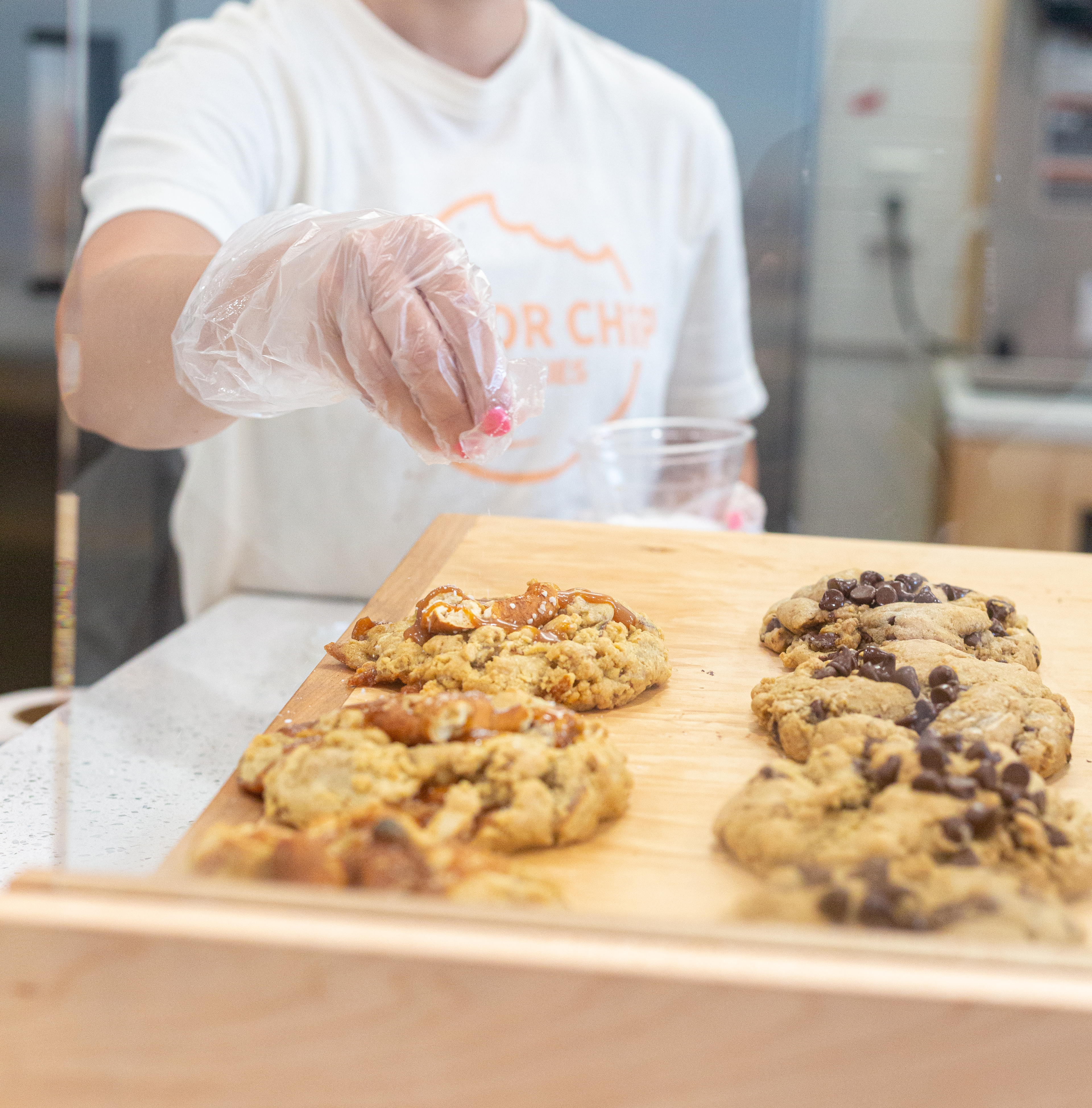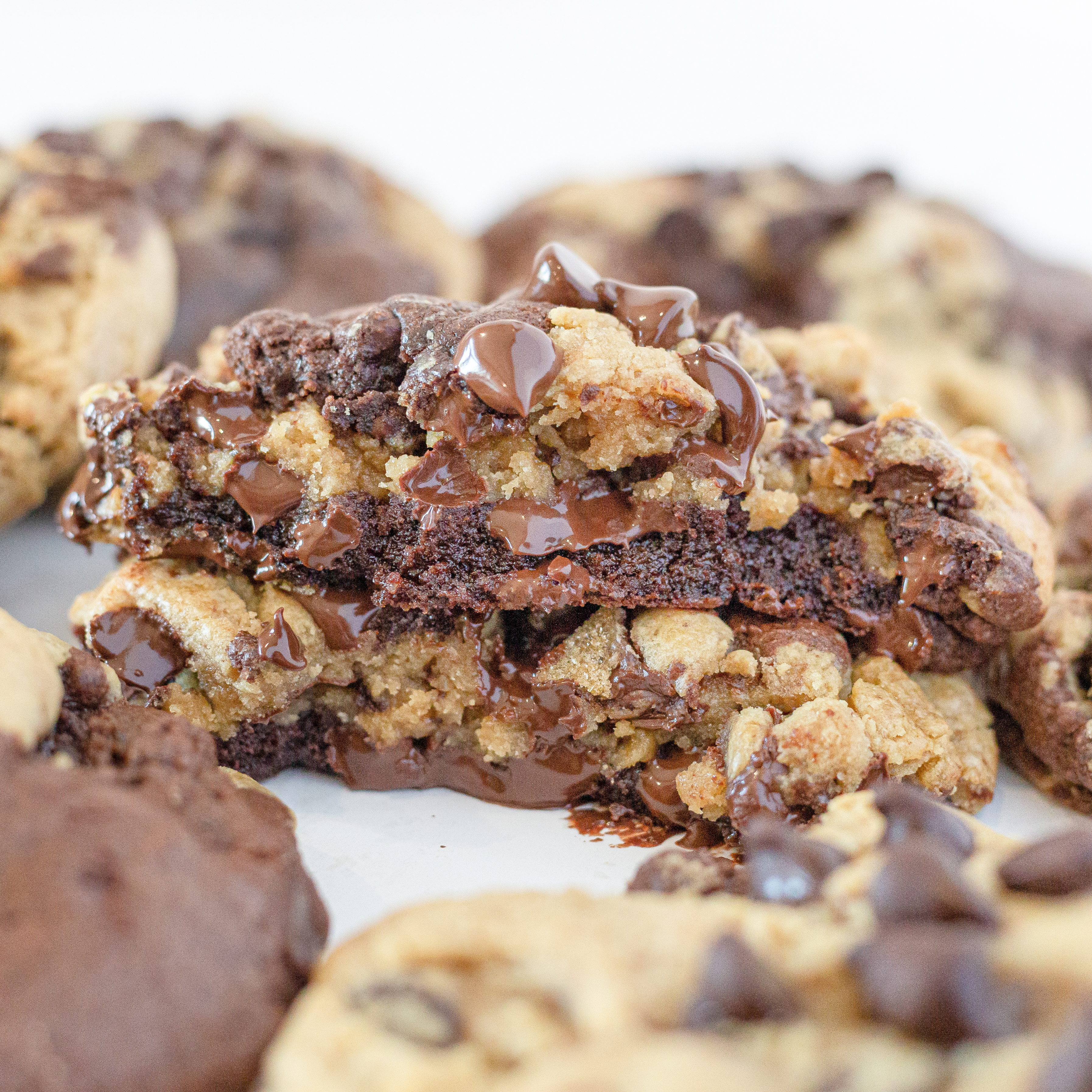Creating biscotti for various dietary needs is straightforward with the right ingredients. For gluten-free versions, use almond and rice flours. If you're vegan, replace eggs with flaxseed or chia seeds mixed in water and opt for coconut oil. Keto-friendly biscotti can use almond flour and low-carb sweeteners. Paleo options use grain-free almond or coconut flour and incorporate nuts or dark chocolate. For a nut-free alternative, explore seed-based recipes, and if you need dairy-free, try non-dairy milk and chocolate. Understanding these substitutions helps meet different dietary requirements while enjoying delicious, crunchy biscotti.
Key Takeaways
- Use almond flour or coconut flour for gluten-free or keto-friendly biscotti.
- Opt for flaxseed or chia seeds as egg replacements in vegan biscotti.
- Choose non-dairy milk and butter substitutes for dairy-free biscotti.
- Incorporate citrus zest or dried fruits in nut-free biscotti for added flavor.
- Store biscotti in an airtight container and freeze for up to three months.
Understanding Dietary Restrictions
When considering dietary restrictions, homemade biscotti offer significant benefits. You can control the ingredients, ensuring they meet specific dietary needs, such as gluten-free or low-sugar options. This not only allows for customization but also guarantees a fresher, healthier treat compared to store-bought versions.
Benefits of Homemade Biscotti
Making homemade biscotti allows you to tailor recipes to suit specific dietary restrictions, making sure everyone can enjoy a delicious treat. Special diet biscotti can be easily modified to accommodate keto or paleo lifestyles by using almond flour and coconut sugar. You can control the ingredients, providing a healthier alternative to store-bought versions.
When you make keto biscotti or paleo biscotti at home, you can guarantee that no unwanted additives or preservatives are included. This makes your biscotti not only tastier but also more nutritious. Using a baking sheet lined with parchment paper ensures even baking and easy cleanup. Once your biscotti achieves that perfect crunchy texture, store them in an airtight container to maintain their freshness.
Homemade biscotti also offers the advantage of customizing flavors and textures according to personal preferences. Whether you're avoiding gluten, dairy, or refined sugars, you have the flexibility to create a treat that meets your needs. Plus, homemade biscotti can be a thoughtful gift for friends and family with dietary restrictions. Exploring various ingredients and techniques can turn baking into an enjoyable and rewarding activity, making special diet biscotti a delightful part of your culinary repertoire.
Gluten-Free Biscotti
When creating gluten-free biscotti, you'll find almond flour and rice flour offer delicious alternatives to traditional wheat flour. Almond flour biscotti deliver a rich, nutty flavor and a delicate texture that pairs perfectly with coffee. On the other hand, rice flour biscotti provide a lighter, crispier option, and you can experiment with various add-ins to enhance their taste.
Almond Flour Biscotti
Almond flour biscotti offer a delicious gluten-free alternative that's perfect for dunking in your morning coffee. To get started, preheat your oven and gather your ingredients. Begin by combining the almond flour, baking powder, and other dry ingredients in a medium bowl. In a separate bowl, whisk together eggs, sugar, and a touch of almond extract to enhance the nutty flavor. Gradually add the wet mixture to the dry ingredients, stirring until a dough forms.
Next, transfer the dough onto a prepared baking sheet lined with parchment paper. Shape it into a log, about 12 inches long and 3 inches wide. Bake in the preheated oven until firm and golden brown. After allowing it to cool slightly, use a serrated knife to slice the log diagonally into 1/2-inch-thick pieces. Arrange the slices back on the baking sheet and bake again until they are crisp.
Once done, transfer the biscotti to a wire rack to cool completely. For an added touch, sprinkle almond slices over the top while still warm. These almond flour biscotti are not only gluten-free but also delightfully crunchy, making them a perfect treat for any time of day.
Rice Flour Biscotti Variations
If you're looking for a gluten-free biscotti with a different twist, rice flour biscotti offers a light and crispy texture that's simply irresistible. Start by combining 1½ cups of rice flour with 1 teaspoon of gluten-free baking powder in a large mixing bowl. Add ½ cup of almond meal for a nutty flavor and texture. In a separate bowl, mix 1/3 cup of melted coconut oil with 2 teaspoons of almond extract.
Gradually combine the wet and dry ingredients, stirring until you achieve a dough-like consistency. Fold in ½ cup of chopped raw almonds for added crunch. Line your baking trays with parchment paper to prevent sticking. Shape the dough into two logs about 12 inches long and 3 inches wide. Place them on the baking trays and put them in a preheated oven at 350°F.
The initial baking time is about 25 minutes. Remove from the oven, let the logs cool slightly, and slice them into ½-inch pieces. Arrange the slices cut-side down on the baking trays and bake for an additional 15-20 minutes until they're golden brown. Cool completely before enjoying your gluten-free biscotti.
Vegan Biscotti
When making vegan biscotti, you'll need to take into account egg replacements and plant-based fat options. Use flaxseed or chia seeds mixed with water as an effective egg substitute. For fats, opt for coconut oil or vegan butter to achieve the right texture and flavor.
Egg Replacements in Biscotti
To create vegan biscotti, you'll need effective egg replacements to achieve the perfect texture and flavor. When traditional recipes call for an egg mixture to bind the biscotti dough, you can use alternatives like flaxseed or chia seeds. For almond flour biscotti, combining one tablespoon of ground flaxseed with three tablespoons of water will create a gel-like consistency that mimics eggs. This mixture works with other ingredients like baking powder, vanilla extract, and almond extract to create the perfect dough.
If you're aiming for gluten-free biscotti, a blend of coconut flour and almond flour is ideal. These flours work well with egg substitutes, maintaining structure and flavor. Don't forget to add olive oil to your biscotti dough; it helps to bring everything together, securing a moist yet firm texture. For those who prefer a more traditional consistency, use gluten-free purpose flour alongside your selected egg replacement. This combination assures your biscotti holds its shape during baking.
Plant-Based Fat Options
Alongside choosing the right egg replacements, selecting the best plant-based fats is crucial to achieving delicious vegan biscotti. The choice of fat impacts texture and flavor, so it's vital to pick the right one. Coconut oil and vegan butter are exceptional plant-based fat options. They both blend well in the flour mixture and help create a rich, crunchy texture.
To begin, preheat your oven to the suitable temperature, typically around 350°F. Prepare your baking tray with parchment paper to avoid sticking. In a large bowl, combine flour, 1 tsp baking powder, and a pinch of salt. In another bowl, mix melted coconut oil or vegan butter with 1 cup of granulated sugar, 1 tsp vanilla extract, and any other flavorings you prefer.
Slowly add the wet ingredients to the flour mixture, stirring until just combined. Fold in almond slivers for an additional crunch. Shape the dough into a log on your baking paper and bake until firm. Once cooled, slice into individual biscotti and bake again until crisp.
Using plant-based fat options guarantees your biscotti are both vegan and delightful, without compromising on texture or flavor.
Sugar-Free Biscotti
When making sugar-free biscotti, you'll want to contemplate using natural sweetener alternatives like stevia or monk fruit to maintain sweetness without the sugar. You can also enhance your biscotti by incorporating sugar-free chocolate for dipping, adding a rich flavor without compromising your dietary needs. These choices guarantee you enjoy a tasty treat while sticking to your sugar-free diet.
Natural Sweetener Alternatives
Switching out sugar for natural sweeteners in your biscotti recipes can create delicious treats without the guilt. Natural sweetener alternatives like stevia, monk fruit, and erythritol can replace refined sugar, offering a healthier option. Unlike brown sugar, these alternatives have minimal impact on blood sugar levels, making them ideal for anyone seeking a low-glycemic diet. When choosing a baking ingredient, consider the texture and sweetness level to make sure your biscotti turns out just right.
For an almond flour biscotti recipe, almond extract adds a delightful flavor, while gluten-free baking powder helps the dough rise. Using food processors can make mixing ingredients easier and faster, ensuring a consistent batter. These sweet treats can be just as satisfying as traditional biscotti, offering a crunchy, delicious cookie experience without the unhealthy sugar.
Incorporating natural sweeteners doesn't compromise taste. Whether you prefer a subtle sweetness or a more pronounced flavor, there's a suitable alternative for every palate. Experimenting with different combinations can lead to new favorites that fit into your dietary needs without sacrificing enjoyment. With a bit of creativity, you can craft biscotti that's both healthy and delectable.
Sugar-Free Chocolate Dipping Options
For a delectable finish to your sugar-free biscotti, consider dipping them in rich, sugar-free chocolate that's both satisfying and guilt-free. These almond biscotti, classic Italian cookies, are perfect for a quick dip or a delicate chocolate drizzle.
Start by baking your biscotti. Preheat your oven and line a baking sheet with parchment paper. Mix together flour, a teaspoon of baking powder, almond extract, and a teaspoon of vanilla extract. Shape the dough into a log and bake until golden. Once cooled, slice the log into individual biscotti pieces and bake again for that signature crunch.
Now, for the exciting part: the chocolate dip. Melt some sugar-free chocolate in a double boiler until it's smooth. Dip each biscotti halfway into the chocolate, allowing excess to drip off before placing them back on the parchment paper. For an elegant touch, consider a chocolate drizzle instead of a full dip. Simply use a fork to drizzle melted chocolate over the biscotti in thin, even lines.
Let the chocolate set completely before enjoying your almond biscotti. These sugar-free treats are perfect for satisfying your chocolate cravings without the guilt. Enjoy them with your favorite cup of coffee or tea!
Keto-Friendly Biscotti
When making keto-friendly biscotti, you'll want to use low-carb flour substitutes like almond or coconut flour to keep the carb count down. These flours not only fit your diet but also add a deliciously nutty flavor to your biscotti. Additionally, incorporating healthy fats such as butter or coconut oil guarantees your biscotti stay rich and satisfying.
Low-Carb Flour Substitutes
You can whip up keto-friendly biscotti by replacing traditional flour with low-carb alternatives like almond flour or coconut flour. These low-carb flour substitutes help you maintain a ketogenic diet while enjoying delicious baked treats. When baking, use gluten-free baking powder to make sure your biscotti rises properly. You might find inspiration from almond butter cookies or a basic almond recipe to get started.
Mixing almond flour with a bit of coconut flour creates a balanced flour blend that results in clean slices and a satisfying texture. For a unique twist, consider adding keto maple walnut to your biscotti for an extra layer of flavor. Your baking skills will improve with practice, so don't hesitate to experiment to suit your personal preference.
High-Fat Keto Biscotti Recipes
To elevate your keto baking game, let's explore high-fat keto biscotti recipes that guarantee every bite is both delicious and diet-friendly. These keto biscotti recipes are perfect for those seeking a low-carb, high-fat treat. Start by mixing almond flour and a low-carb sweetener in a bowl. Incorporate gluten-free baking powder to make sure your biscotti rise properly.
Next, whisk together large eggs, melted butter, and a dash of almond extract in another bowl. Combine this butter-egg mixture with your dry ingredients until a dough forms. This step makes certain your biscotti have the perfect texture.
For added flavor, fold in some sugar-free chocolate chips. Shape the dough into a log and place it on a baking sheet lined with parchment paper. The first baking step involves baking the log until it's firm but not fully cooked.
Once cooled, slice the log into individual biscotti pieces and return them to the baking sheet. Bake again until they achieve that classic biscotti crunch. By following these steps, you'll create keto-friendly biscotti that are not only tasty but also fit seamlessly into your low-carb lifestyle. Enjoy your gluten-free, high-fat delight!
Paleo Biscotti
When making Paleo biscotti, you'll start with a grain-free base that typically includes almond flour or coconut flour. To keep it Paleo-approved, consider adding mix-ins like nuts, dried fruit, or dark chocolate. These ingredients not only adhere to Paleo guidelines but also add delicious texture and flavor to your biscotti.
Grain-Free Biscotti Base
For a delicious and healthy twist on traditional biscotti, the grain-free base offers a perfect paleo-friendly alternative. Start by gathering your ingredients from the baking aisle. You'll need almond flour, baking powder, and a touch of almond extract or almond essence to add depth to the flavor. This grain-free biscotti base is also naturally gluten-free, making it suitable for various dietary needs.
First, pre-heat the oven to 350°F (175°C). While the oven warms up, mix the almond flour, baking powder, and a pinch of salt in a bowl. In a separate bowl, combine the wet ingredients, including eggs and almond extract. Blend the dry and wet mixtures until a thick biscotti mixture forms.
Next, line a baking sheet with parchment paper. Shape the dough into a log and place it on the prepared sheet. Bake for about 25 minutes or until the edges are golden. Let it cool for 10 minutes, then slice the log into individual cookies. Arrange the slices back on the parchment paper and bake again for another 10 minutes to achieve that classic biscotti crunch. Enjoy your grain-free, paleo-friendly biscotti with a cup of coffee or tea!
Paleo-Approved Mix-Ins
Improve your grain-free biscotti by adding paleo-approved mix-ins like chopped nuts, dried fruits, and dark chocolate chunks. These mix-ins can elevate your biscotti, making them as delightful as traditional biscotti, but perfectly suited for a paleo diet. Your baking cupboard likely already contains many of these simple ingredients, allowing you to create delicious treats without a special trip to the store.
Start with chopped almonds for texture and a satisfying crunch. Almonds pair wonderfully with coconut flour, a staple in paleo baking. Next, consider adding dried fruit such as cranberries or apricots. These not only add natural sweetness but also bring a chewy contrast to the biscotti's crispness. For a touch of indulgence, mix in dark chocolate chunks. Choose a chocolate that's at least 70% cacao to keep it paleo-friendly.
Don't forget a splash of almond extract to enhance the nutty flavor, and guarantee you're using gluten-free baking powder to keep your biscotti entirely grain-free. With these paleo-approved mix-ins, you can enjoy biscotti that's both delicious and compliant with your dietary needs. Simple ingredients make all the difference in transforming your biscotti into a paleo delight.
Nut-Free Biscotti
Creating nut-free biscotti is easier than you think, and you won't have to compromise on flavor. Consider using seed-based recipes that offer a crunchy texture similar to nuts. Additionally, explore nut-free flavor enhancements like citrus zest, vanilla, or dried fruits to add a delightful twist.
Seed-Based Recipes
If you're seeking a delectable and nut-free alternative to traditional biscotti, seed-based recipes provide a crunchy and flavorful choice. Kick off with a fodmap recipe that utilizes a gluten-free baking powder and a specially formulated baking flour blend. Even if you prefer almonds, you can still attain that familiar taste by incorporating almond extract in your recipe.
Commence by blending your initial cookie dough with your selected egg replacement until you achieve a silky dough. Utilize a mix of seeds such as sunflower, pumpkin, and chia for a delightful crunch. Spread the dough onto a parchment paper-lined baking sheet, molding it into a lengthy, flat log. Bake it at the recommended temperature until it transforms into a pale golden brown.
After baking, allow the log to cool slightly before cutting it into individual biscotti pieces. Arrange these slices back on the parchment paper and bake again until they're crunchy. This dual-baking technique guarantees that your seed-based biscotti have the ideal texture.
These nut-free biscotti are ideal for individuals with allergies or sensitivities, enabling everyone to relish a delightful treat.
Nut-Free Flavor Enhancements
One way to enhance the flavor of your nut-free biscotti is by incorporating aromatic spices like cinnamon, cardamom, or ginger into the dough. These spices not only add warmth but also depth, making each bite more intricate. To replicate the nutty essence traditionally found in biscotti, try adding a teaspoon almond extract. Although it's an almond derivative, the extract itself is nut-free and safe for those with allergies.
For a chocolate version of this classic treat, mix in some cocoa powder or chopped dark chocolate. The richness of chocolate pairs beautifully with spices, creating a delightful balance. If you're avoiding gluten, use gluten-free baking powder along with your preferred gluten-free baking flour. This guarantees your biscotti stays light and crunchy without compromising on texture or flavor.
You might also experiment with flavors like maple walnut, substituting the nuts with seeds or dried fruits for that added crunch. These nut-free flavor enhancements make it easy to enjoy biscotti without chunks of almonds or other nuts. By adjusting the original recipe with these suggestions, you'll create a delicious, allergy-friendly treat everyone can enjoy.
Dairy-Free Biscotti
When making dairy-free biscotti, you'll want to explore the variety of non-dairy milk options available, such as almond, oat, or coconut milk. These alternatives can add unique flavors and textures to your biscotti. Additionally, don't overlook dairy-free chocolate coatings, which can add a delicious finishing touch without compromising on taste.
Non-Dairy Milk Options
Switching to non-dairy milk can make your biscotti both delicious and suitable for those with lactose intolerance or dairy allergies. You have several non-dairy milk options to choose from, such as almond milk, soy milk, oat milk, and coconut milk. These alternatives can seamlessly replace traditional dairy milk in your recipe, guaranteeing a rich texture and flavor.
To make classic almond biscotti from scratch, start by preheating your oven and lining a cookie sheet with parchment paper. In the bowl from your mixer, combine your chosen non-dairy milk, almond extract, and sweeteners. Add in gluten-free baking powder and baking powder (aluminum free) to secure a proper rise. Gradually add flour until you form a heavy dough.
Shape the dough into logs and place them on the parchment paper-lined cookie sheet. Bake until firm, then slice the logs into individual biscotti pieces and bake again for that signature crunch. These steps will help you achieve delicious, dairy-free biscotti that everyone can enjoy.
Dairy-Free Chocolate Coatings
After mastering non-dairy milk options for your biscotti, let's explore how to create dairy-free chocolate coatings that add an extra layer of indulgence. Start by choosing high-quality dairy-free chocolate, such as dark chocolate or a specific dairy-free brand. Melt your chocolate slowly to avoid burning, and make sure you coat parchment paper on your work surface for easy cleanup.
Maintaining your biscotti dough structure is essential. Using gluten-free baking powder helps achieve the right texture, especially if you're making gluten-free biscotti. When your baked cookie dough is ready, let it cool slightly before dipping. For a flawless chocolate dunk, hold each biscotti piece by one end and dip into the melted chocolate, letting excess drip off before placing it on the parchment.
If you love chocolate chip cookies, you'll adore incorporating a chocolate chip base into your biscotti. Alternatively, for a rich flavor, try chocolate hazelnut biscotti. The sweet almond flavor pairs wonderfully with dairy-free chocolate coatings, creating a delightful contrast.
For an even coating, you might consider drizzling additional melted chocolate over the dipped biscotti. This method makes certain every bite has a perfect balance of biscotti and chocolate.
Low-FODMAP Biscotti
When creating Low-FODMAP biscotti, you'll want to focus on using ingredients that are gentle on your digestive system. Options like almond flour and lactose-free chocolate chips can help you stick to your diet without sacrificing taste. You can also explore various flavor variations, such as using orange zest or ginger, to keep your biscotti interesting and delicious.
FODMAP-Friendly Ingredients
Crafting a delicious low-FODMAP biscotti starts with carefully selecting the right ingredients. Begin with a basic recipe that's designed to be FODMAP-friendly. Use a digital food scale to measure ingredients accurately, ensuring consistency every time. Key components include gluten-free baking powder and almond extract. Almonds, commonly used in biscotti, should be chopped into larger pieces for texture and flavor.
When baking, line your baking sheet with parchment paper to prevent sticking and make cleanup easier. Bake your biscotti for 25-30 minutes until they're golden brown. Remember to let them cool completely before storing, as biscotti cool and harden, achieving their signature crunch.
Here's a quick guide to FODMAP-friendly ingredients:
- Flours and Starches: Opt for almond flour, rice flour, or gluten-free all-purpose flour.
- Sweeteners: Use white or brown sugar, maple syrup, or stevia.
- Nuts and Seeds: Stick to almonds, pecans, or chia seeds in moderation.
Flavor Variations for Low-FODMAP Diets
Exploring flavor variations in low-FODMAP biscotti allows you to enjoy diverse and delightful tastes without compromising your diet. By incorporating low-FODMAP ingredients, you can create an Italian cookie that remains both delicious and diet-friendly.
Start by using gluten-free baking powder to guarantee your biscotti is suitable for low-FODMAP diets. Adding almond extract will give your biscotti a rich, nutty flavor that complements many ingredients. As you mix your dough, use a wooden spoon to combine everything evenly until the dough forms properly.
When it's time to bake, line your baking sheet with baking paper to prevent sticking. Shape the dough into logs and bake until firm. Once cooled, use a sharp knife to slice the logs into individual biscotti pieces. For an airier texture, consider baking the slices a second time to achieve that perfect crunch.
Pair your low-FODMAP biscotti with hot chocolate for a cozy treat. The combination of flavors can make for a delightful experience without disturbing your digestive system. Enjoy experimenting with different ingredients and find your favorite low-FODMAP biscotti variations to share with friends and family.
Baking Tips for Special Diet Biscotti
When baking special diet biscotti, pay attention to texture by using the right balance of ingredients to achieve the perfect crunch. Proper storage is essential to maintain their freshness and extend shelf life, so keep them in an airtight container. Don't forget to let them cool completely before storing to prevent any moisture buildup.
Texture Considerations
To achieve the perfect texture for special diet biscotti, focus on balancing moisture levels and baking times. Start by using 1 tsp gluten-free baking powder to guarantee proper rise and structure. Opt for baking powder (aluminum-free) to dodge any metallic aftertaste. Slicing your biscotti dough into 1/2-3/4 inch slices helps maintain uniformity and even baking.
Here are three essential tips to master the texture:
-
Moisture Control: Incorporate eggs to the mixture to provide moisture without making the dough too sticky. Soft sugar can also help retain some moisture, aiding in a softer interior while still achieving that classic biscotti crunch.
-
Baking Times: Pre-bake your slices for 28-30 minutes to set the structure. Then, after slicing, bake them for an additional 12-15 minutes per side. This helps achieve the perfect balance between a firm exterior and a slightly tender interior. For a crisper texture, extend the final bake to 33-35 minutes.
-
Baking Surface: Use a silicone baking mat to guarantee even baking and easy removal. This prevents sticking and allows the biscotti to maintain their shape and volume during baking.
Following these tips will help you achieve the ideal texture for your special diet biscotti.
Storage and Shelf Life
Once you've achieved the perfect texture, storing your special diet biscotti properly secures they stay fresh and delicious for as long as possible. To extend their storage and shelf life, let the biscotti cool completely on a tray with baking paper. Once cool, transfer them to an airtight container. This will prevent moisture from making them soggy. If you prefer to have a biscotti with morning coffee, consider storing a small batch in a cookie jar for easy access. For longer storage, place them in a freezer-safe bag and freeze for up to three months.
When baking, using a sheet with parchment paper can help prevent sticking and ensure even cooking. Typical baking times range from 12-16 minutes, so keep an eye on them to avoid overbaking. A bread knife can be useful for slicing the biscotti evenly, ensuring each piece bakes uniformly. Remember, using aluminum free baking powder can provide a purer taste. Unlike classic sugar cookies, biscotti benefit from a dry, crisp texture, making them perfect for dipping in a cup of coffee. Following these tips will help you enjoy your special diet biscotti at their best.
The Taylors and Taylor Chip
Baking together in 2015, Sara and Dougie Taylor turned their shared passion for sweets into the beloved brand Taylor Chip. As newly dating partners, they found baking to be a fun and creative outlet. Their love for each other and their baking skills grew hand-in-hand, leading them to perfect their cookie recipe just in time for their wedding. Their journey is an inspiring example of how a shared hobby can turn into a successful business.
The Taylor Chip Brookie Cookie
Combining the rich, fudgy goodness of a double chocolate brownie with the classic delight of a chocolate chip cookie, the Taylor Chip Brookie Cookie delivers an irresistible treat. Made with quality ingredients like unbleached enriched wheat flour, Wilbur semisweet chocolate, and locally extracted vanilla, these cookies are baked and shipped the same day from Lancaster, Pennsylvania. The use of aluminum-free baking powder guarantees a pure taste without any metallic aftertaste.
For a unique pairing, consider enjoying your Brookie Cookie with a glass of vin santo, an Italian dessert wine. Whether you bake at home or enjoy the convenience of express shipping from Taylor Chip, this cookie is a must-try.
Frequently Asked Questions
How Can I Store Biscotti to Keep Them Fresh?
To keep biscotti fresh, store them in an airtight container at room temperature. Make sure they're completely cooled before sealing. If you want them to last longer, you can freeze them. Place the biscotti in a freezer-safe bag or container, and they'll stay good for up to three months. Just let them thaw at room temperature before enjoying them. Avoid refrigerating, as it can make them stale faster.
Can I Freeze Biscotti Dough for Later Use?
Yes, you can freeze biscotti dough for later use. Just shape the dough into logs, wrap them tightly in plastic wrap, and place them in a freezer-safe bag or container. When you're ready to bake, let the dough thaw in the refrigerator overnight. This method guarantees the dough remains fresh, and you can enjoy homemade biscotti anytime without the hassle of starting from scratch.
What Are Some Common Biscotti Flavor Variations?
You can find many common biscotti flavor variations to enjoy. Traditional almond biscotti are always a hit. Chocolate lovers might prefer double chocolate or chocolate hazelnut. Citrus flavors like lemon or orange zest add a invigorating twist. Some variations include dried fruits, such as cranberry or cherry, for a sweet and tangy taste. Spices like cinnamon or anise can also be used to create warm, aromatic biscotti.
How Long Do Biscotti Typically Last?
Biscotti typically last for two weeks when stored in an airtight container at room temperature. If you want them to stay fresh longer, you can freeze them for up to three months. Just make sure to let them cool completely before freezing. When you're ready to enjoy them, thaw at room temperature. This way, you'll maintain their crisp texture and delicious flavor. Remember, proper storage is key.
Can I Add Mix-Ins Like Chocolate Chips to Special Diet Biscotti Recipes?
Yes, you can add mix-ins like chocolate chips to biscotti recipes. Just make sure they align with the special diet requirements. For example, if you're making gluten-free biscotti, use gluten-free chocolate chips. Mix the chips into the dough before shaping and baking. This way, the chocolate chips will be evenly distributed, giving each bite a delicious touch. Always check the ingredient compatibility for the best results.
Conclusion
By understanding dietary restrictions, you can bake delicious biscotti for everyone. Whether you're making gluten-free, vegan, sugar-free, keto-friendly, or low-FODMAP biscotti, there's a recipe tailored to meet specific needs. Remember to follow baking tips for the best results. With these guidelines, you'll be able to create delightful treats like The Taylors' special biscotti or the Taylor Chip Brookie Cookie. Enjoy the process and the satisfaction of accommodating diverse dietary preferences.










